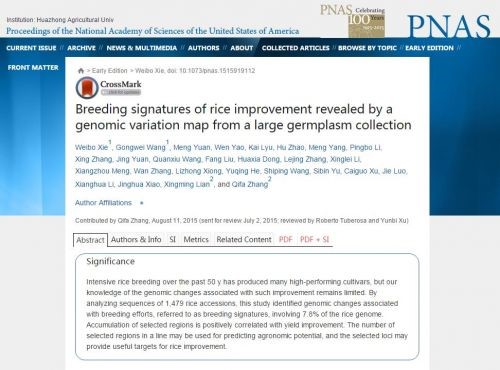
Breeding signatures of rice improvement revealed by a genomic variation map from a large germplasm collection,a paper by National Key Laboratory for Crop Genetic Improvement has been adopted by Proceedings of the National Academy of Sciences (PNAS), a significant achievement in rice genome made by HZAU rice research team.
By analyzing large numbers of rice genomic variations, the study identified the selected genetic parts in rice breeding, or “breeding signatures of rice improvement”, and discovered that the number of breeding signatures was positively correlated with the output, which suggests that the former may be useful for predicting the potential output of a new variation. Moreover, the identified parts provide targets for rice improvement. The paper’s communicators are Professor Qifa Zhang and Xingming Lian, and Associate Professor Weibo Xie and Gongwei Wang are first co-authors .
Traditionally, rice can be divided into two main subpopulations, indica and japonica. Indica outputs have more than doubled during the past 50 years, one of the main reasons being the widespread use of chemical fertilizers, while the root causes are the genetic improvement of rice as demonstrated by a series of landmark achievements. The use of chemical fertilizer has changed the rice cultivation conditions, making the high-stalk varieties no longer adaptable to the production requirements due to their poor resistance to fertilizer and lodging. In 1950s and 1960s, China and the International Rice Research Institute (IRRI) chose and bred series of semi-dwarf rice varieties with fertility resistance. Such a breakthrough facilitated "Green Revolution" of rice breeding. Since then, nearly all of the modern rice had the basic features of semi-dwarf rice. Breeders improved other traits based on the semi-dwarf rice varieties, including the broad spectrum of multi-resistant and better-quality rice. Another breakthrough was made in application of hybrids. Since 1970s, large- scale promotion of hybrid rice maintained steady growth in outputs. Despite the fact that rice breading had generated impressive results, people still had little knowledge of selected genes in rice breeding.
Based on the RiceVarMap, the rice genomic variation map constructed in previous studies, the study analyzed the population structure of Indica subspecies and identified the two main subgroups: indicaI and indicaII. It was found that the two indicas had different geographical origins, and their formation may be related to the independent breeding carried out by China and the International Rice Research Institute early on. Furthermore, the study finds that the number of the "breeding marks" is proportional to the output of the variety, suggesting that the breeding marks number can possibly be used to predict the breeding potential of this species. Since parents of hybrid rice are from two different subsets, hybrid rice has more breeding marks than their parents. This shows the heterosis may have some correlations with breeding marks. Identification of breeding marks provides an important target for further improvement of rice, and will play a role in improving genome breeding strategies.